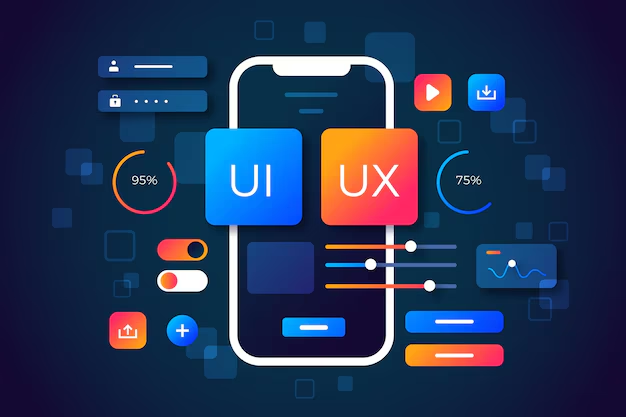
Blog
UI/UX Design: Crafting Seamless Experiences and Intuitive Interfaces with CodriveIT

In today's competitive digital landscape, a great idea is only as powerful as its execution. And in the world of software, the execution that truly matters lies in its User Interface (UI) and User Experience (UX). At CodriveIT, we believe that exceptional UI/UX design is not merely about aesthetics; it's about engineering intuitive, efficient, and delightful interactions that captivate users and drive tangible business results.
UI vs. UX: Understanding the Core Differences
While often used together, UI and UX represent distinct yet interconnected disciplines crucial for any successful digital product:
User Experience (UX) Design: This is the broader discipline, focusing on how a user feels when interacting with a product. It's about the entire journey – from the moment a user considers using the product to the completion of their tasks and beyond. UX designers conduct research, map user journeys, define information architecture, and ensure the product is useful, usable, and desirable. It's about understanding needs, problem-solving, and optimizing the flow and functionality.
User Interface (UI) Design: This focuses on how a product looks and feels. It's the visual and interactive part of the software that users directly manipulate. UI designers craft the aesthetic elements – buttons, icons, typography, color schemes, layouts, and animations – to ensure the interface is visually appealing, consistent, and easy to interact with. It's about visual hierarchy, brand consistency, and the presentation of information.
In essence: UX is the blueprint and the flow, while UI is the interior design and the visual presentation. A great product requires both to work in harmony; a beautiful UI with a frustrating UX will fail, just as a highly functional UX with a confusing UI will struggle to gain adoption.
Why Investing in Expert UI/UX Design is a Business Imperative:
Poor UI/UX design is a leading cause of user abandonment, reduced conversions, and increased support costs. Conversely, a well-designed product offers significant benefits:
- Increased User Engagement & Retention: Intuitive navigation, clear visual cues, and delightful interactions keep users coming back. An enjoyable experience fosters loyalty and reduces churn.
- Higher Conversion Rates & ROI: When users can easily find what they need and effortlessly complete tasks (e.g., making a purchase, signing up for a service), conversion rates skyrocket. Studies have shown significant ROI on UX investments.
- Enhanced Brand Credibility & Trust: A polished, professional, and user-friendly interface communicates professionalism and attention to detail. It builds trust and reinforces your brand's legitimacy in the market.
- Reduced Development Costs & Time-to-Market: Identifying and rectifying usability issues during the design phase (before coding begins) saves significant time and resources on costly rework later in the development cycle.
- Minimized Support & Training Costs: An intuitive product requires less hand-holding. Clear UI/UX minimizes user confusion, leading to fewer support queries and reduced training needs.
- Competitive Advantage: In a crowded market, a superior user experience can be the key differentiator that attracts and retains customers, setting your product apart from competitors.
- Better SEO Performance: Search engines prioritize user experience. Websites with good UI/UX (fast loading times, clear navigation, engaging content) tend to rank higher in search results.
- Improved Accessibility: Designing with UI/UX principles ensures your product is usable by everyone, including people with disabilities, broadening your audience and fulfilling ethical and legal obligations.
CodriveIT's Comprehensive UI/UX Design Process:
At CodriveIT, our UI/UX design team combines creativity with data-driven insights to create exceptional digital experiences. Our iterative, user-centered approach ensures that every design decision is intentional and impactful:
Discovery & User Research (UX Focus):
- Understanding Your Business: We deep-dive into your business goals, target audience, competitive landscape, and key performance indicators.
- User Research: Through interviews, surveys, persona creation, and user journey mapping, we gain a profound understanding of user needs, behaviors, pain points, and motivations.
- Competitor Analysis: We analyze the strengths and weaknesses of competitor products to identify opportunities for differentiation.
Information Architecture (UX Focus):
- Organizing content and features in a logical, intuitive way that users can easily navigate. This involves creating sitemaps and defining content hierarchies.
Wireframing & Prototyping (UX & UI Focus):
- Wireframes (Low-Fidelity): We create skeletal outlines of screens, focusing on layout, content structure, and basic functionality.
- Prototypes (High-Fidelity): We build interactive, clickable models that simulate the actual user experience, allowing for early testing and iterative feedback before a single line of code is written.
User Interface (UI) Design:
- Visual Design: Crafting the aesthetics, including color palettes, typography, iconography, imagery, and overall visual style, consistent with your brand guidelines.
- Interaction Design: Defining how users interact with elements (e.g., button states, animations, transitions) to provide clear feedback and a delightful experience.
- Responsive Design: Ensuring the interface adapts seamlessly across various devices and screen sizes (desktops, tablets, mobile phones).
Usability Testing & Iteration:
- We conduct usability tests with real users to observe their interactions, identify pain points, and gather valuable feedback.
- Based on these insights, we iterate on the designs, making improvements to optimize the user experience.
Design System Development (Optional but Recommended):
- For larger projects, we can develop a comprehensive design system that includes a library of reusable UI components, style guidelines, and design principles. This ensures consistency, accelerates future development, and simplifies maintenance.
Handoff to Development:
- We provide developers with meticulously prepared assets, comprehensive style guides, and clear documentation to ensure precise implementation of the design.





